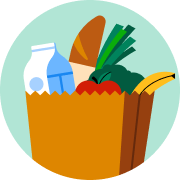
Fast delivery
Get in as fast as 1 hour

It’s all local
Shop your favorites

Direct chat
Connect with shoppers






Ball Pint Jars

Ball Pint Jars
12 ctPopular item

100% satisfaction guarantee
Place your order with peace of mind.

Recent reviews
Apr 2024
Order delivered in 48 min
Customer since 2019
Middleport, NY
Apr 2024
Order delivered in 42 min
Customer since 2024
Le Roy, NY
Apr 2024
Order delivered in 59 min
Customer since 2020
Elba, NY
About
Details
The brand you trust. BPA free. Freezer safe. With lids & bands. For preserving food. Enjoy your preserved foods within one year! Over 130 years of research, testing and advancing the art of fresh preservation go into every product we sell. For recipes, tips or questions FreshPreserving.com; 800-240-3340 M-F 8:30 am to 4:30 pm (EST). Please recycle. Made in USA.
Ingredients
Half Pint Jars Wide Mouth.
Directions
Canning in 3 Easy Steps: 1. Prepare your gear. Wash & heat your jars and lids. 2. Create your recipe. Use a tested recipe for home canning, see the Ball Blue Book guide to preserving or FreshPreserving.com. 3. Preserve your foods. Fill your clean jars. Boil in waterbath or pressure canner for time specified in recipe. Choose the jar that fits your needs: Jar Size - Choose from over 6 jar sizes. Some jars have shoulders while others have straight sides that work best for freezing. Your recipe will guide you on the recommended jar sizes. Here are some suggestions to get you started, see chart. Mouth Size - The diameter of the jar opening determines the mouth size. Choose from either regular or wide mouth sizes. All Jelly Jars have a regular mouth. Regular Mouth works best with pourable foods such as jams and jellies, salsas, sauces and the fillings or chopped fruits and vegetables. Wide Mouth works best with whole fruits and vegetables or when you need a large mouth for filling. Ball Complete Home Canning Instructions: What You Need: Canning recipe - See Ball Blue Book guide to preserving or FreshPreserving.com for recipes. Fresh ingredients. Jar and two-piece lids (lids and bands). Prepare Your Gear & Create Your Recipe: Wash jars, lids and bands in hot, soapy water. Rinse well. Jars must be kept warm until ready to use, in order to minimize risk of breakage when filling with hot food. You can heat them in the pot of simmering water, or in a heated dishwasher. Prepare food using fresh ingredients and a tested recipe for home canning. Waterbath Canning: To can: Tomatoes, salsa, pickles, jellies, jams, fruits (whole, sauces, chutneys, pie fillings, etc) and other high-acid foods. You also need Ball 21-Quart Waterbath Canner or equally large stockpot with a Ball Canning Rack, or for small batches, a Ball Canning Discovery Kit. Prepare Jars: Fill pot with enough water to cover jars with at least 1 inch of water and heat to simmer (180 degrees F). Fill each hot jar with prepared food. Follow canning recipe for correct fill-level. Each jar needs space between the food and the rim (headspace) to allow for food expansion. Tip: Air bubbles inside jar can impact cooking effectiveness. Remove bubbles by sliding a small non-metallic spatula inside the jar, gently pressing food against the side of the jar. Wipe any food from the jar. Center new lid on the jar, then twist on band just until fingertip tight. Ensure bands are not over-tight - air inside jar must be able to escape during canning. Process Jars: Place filled jars onto rack, then lower into simmering water, ensuring jars are covered by 1 inch of water. Cover with lid, and heat to steady boil. Boil jars for the time specified in recipe, adjusting for altitude (see chart). Turn off heat and let jars stand in water for 5 minutes. Remove from water and cool jars upright on wire rack or towel on countertop for 12 hours. Tip: After removing jars from the canner, do not re-tighten bands that may have come loose during canning, so as not to interfere with the sealing process within the first 12 hours. Pressure Canning: To can green beans, carrots, beets, meats, fish or other low-acid foods. You also need Pressure Canner. Prepare Jars: Heat 3 inches of water to simmer (180 degrees F) and follow manufacturer instructions. Fill each hot jar with prepared food. Follow canning recipe for correct fill-level. Each jar needs space between the food and the rim (headspace) to allow for food expansion. Tip: Air bubbles inside jar impact cooking effectiveness. Remove bubbles by sliding a small non-metallic spatula inside the jar, gently pressing food against the side of the jar. Wipe any food from the rim of the jar. Center new lid on the jar, then twist on band just until fingertip tight. Ensure bands are not over-tight - air inside jar must be able to escape during canning. Process Jars: Place filled jars onto rack. Canner should contain 2 to 3 inches of simmering water. Lock canner lid into place Turn heat to medium-high and open vent. Bring to boil and vent a steady stream of steam for 10 minutes. Put weight on vent and adjust heat to achieve 10 pounds pressure, adjusting for altitude (see chart). Process for time listed in recipe, keeping pressure steady. Follow manufacturer's guidelines for cooling and removing pressure canner lid. Remove from water and cool jars upright on wire rack or towel on countertop for 12 hours. Tip: After removing jars from the canner, do not re-tighten bands that may have come loose during canning, so as not to interfere with the sealing process within the first 12 hours. Check the Seal: Press on center of cooled lid. If jar is fully sealed, the lid will not flex up or down. If the lid flexes, the jar did not seal properly. You may refrigerate for immediate use. Or for directions on how to safely re-process the jar, see freshPreserving.com or the Ball Blue Book guide to preserving for detailed instructions. Store sealed jars in pantry for up to 1 year. Jars may be stored without bands, or you may clean underside of bands to ensure no moisture is trapped during storage. Enjoy your homemade food or give as a gift. Altitude Chart: If you are preserving at an altitude higher than 1,000 feet above sea level, adjust waterbath processing time as indicated for waterbath canning. For pressure canning, adjust pounds pressure as indicated. For Waterbath Canning: 1,001-3,000 Feet: increase processing time 5 minutes. 3,001-6000 Feet: increase processing time 10 minutes. 6,001-8,000 Feet: increase processing time 15 minutes. 8,001-10,000 Feet: increase processing time 20 minutes. For Pressure Canning: 0-1,000 Feet: 10 weighted gauge; 11 dial gauge. 1,001-2,000 Feet: 15 weighted gauge; 11 dial gauge. 2,001-4,000 Feet: 15 weighted gauge; 12 dial gauge. 4,001-6,000 Feet: 15 weighted gauge; 13 dial gauge. 6,001-8,000 Feet: 15 weighted gauge; 14 dial gauge. 8,001-10,000 Feet: 15 weighted gauge; 15 dial gauge.
About
Details
The brand you trust. BPA free. Freezer safe. With lids & bands. For preserving food. Enjoy your preserved foods within one year! Over 130 years of research, testing and advancing the art of fresh preservation go into every product we sell. For recipes, tips or questions FreshPreserving.com; 800-240-3340 M-F 8:30 am to 4:30 pm (EST). Please recycle. Made in USA.
Ingredients
Half Pint Jars Wide Mouth.
Directions
Canning in 3 Easy Steps: 1. Prepare your gear. Wash & heat your jars and lids. 2. Create your recipe. Use a tested recipe for home canning, see the Ball Blue Book guide to preserving or FreshPreserving.com. 3. Preserve your foods. Fill your clean jars. Boil in waterbath or pressure canner for time specified in recipe. Choose the jar that fits your needs: Jar Size - Choose from over 6 jar sizes. Some jars have shoulders while others have straight sides that work best for freezing. Your recipe will guide you on the recommended jar sizes. Here are some suggestions to get you started, see chart. Mouth Size - The diameter of the jar opening determines the mouth size. Choose from either regular or wide mouth sizes. All Jelly Jars have a regular mouth. Regular Mouth works best with pourable foods such as jams and jellies, salsas, sauces and the fillings or chopped fruits and vegetables. Wide Mouth works best with whole fruits and vegetables or when you need a large mouth for filling. Ball Complete Home Canning Instructions: What You Need: Canning recipe - See Ball Blue Book guide to preserving or FreshPreserving.com for recipes. Fresh ingredients. Jar and two-piece lids (lids and bands). Prepare Your Gear & Create Your Recipe: Wash jars, lids and bands in hot, soapy water. Rinse well. Jars must be kept warm until ready to use, in order to minimize risk of breakage when filling with hot food. You can heat them in the pot of simmering water, or in a heated dishwasher. Prepare food using fresh ingredients and a tested recipe for home canning. Waterbath Canning: To can: Tomatoes, salsa, pickles, jellies, jams, fruits (whole, sauces, chutneys, pie fillings, etc) and other high-acid foods. You also need Ball 21-Quart Waterbath Canner or equally large stockpot with a Ball Canning Rack, or for small batches, a Ball Canning Discovery Kit. Prepare Jars: Fill pot with enough water to cover jars with at least 1 inch of water and heat to simmer (180 degrees F). Fill each hot jar with prepared food. Follow canning recipe for correct fill-level. Each jar needs space between the food and the rim (headspace) to allow for food expansion. Tip: Air bubbles inside jar can impact cooking effectiveness. Remove bubbles by sliding a small non-metallic spatula inside the jar, gently pressing food against the side of the jar. Wipe any food from the jar. Center new lid on the jar, then twist on band just until fingertip tight. Ensure bands are not over-tight - air inside jar must be able to escape during canning. Process Jars: Place filled jars onto rack, then lower into simmering water, ensuring jars are covered by 1 inch of water. Cover with lid, and heat to steady boil. Boil jars for the time specified in recipe, adjusting for altitude (see chart). Turn off heat and let jars stand in water for 5 minutes. Remove from water and cool jars upright on wire rack or towel on countertop for 12 hours. Tip: After removing jars from the canner, do not re-tighten bands that may have come loose during canning, so as not to interfere with the sealing process within the first 12 hours. Pressure Canning: To can green beans, carrots, beets, meats, fish or other low-acid foods. You also need Pressure Canner. Prepare Jars: Heat 3 inches of water to simmer (180 degrees F) and follow manufacturer instructions. Fill each hot jar with prepared food. Follow canning recipe for correct fill-level. Each jar needs space between the food and the rim (headspace) to allow for food expansion. Tip: Air bubbles inside jar impact cooking effectiveness. Remove bubbles by sliding a small non-metallic spatula inside the jar, gently pressing food against the side of the jar. Wipe any food from the rim of the jar. Center new lid on the jar, then twist on band just until fingertip tight. Ensure bands are not over-tight - air inside jar must be able to escape during canning. Process Jars: Place filled jars onto rack. Canner should contain 2 to 3 inches of simmering water. Lock canner lid into place Turn heat to medium-high and open vent. Bring to boil and vent a steady stream of steam for 10 minutes. Put weight on vent and adjust heat to achieve 10 pounds pressure, adjusting for altitude (see chart). Process for time listed in recipe, keeping pressure steady. Follow manufacturer's guidelines for cooling and removing pressure canner lid. Remove from water and cool jars upright on wire rack or towel on countertop for 12 hours. Tip: After removing jars from the canner, do not re-tighten bands that may have come loose during canning, so as not to interfere with the sealing process within the first 12 hours. Check the Seal: Press on center of cooled lid. If jar is fully sealed, the lid will not flex up or down. If the lid flexes, the jar did not seal properly. You may refrigerate for immediate use. Or for directions on how to safely re-process the jar, see freshPreserving.com or the Ball Blue Book guide to preserving for detailed instructions. Store sealed jars in pantry for up to 1 year. Jars may be stored without bands, or you may clean underside of bands to ensure no moisture is trapped during storage. Enjoy your homemade food or give as a gift. Altitude Chart: If you are preserving at an altitude higher than 1,000 feet above sea level, adjust waterbath processing time as indicated for waterbath canning. For pressure canning, adjust pounds pressure as indicated. For Waterbath Canning: 1,001-3,000 Feet: increase processing time 5 minutes. 3,001-6000 Feet: increase processing time 10 minutes. 6,001-8,000 Feet: increase processing time 15 minutes. 8,001-10,000 Feet: increase processing time 20 minutes. For Pressure Canning: 0-1,000 Feet: 10 weighted gauge; 11 dial gauge. 1,001-2,000 Feet: 15 weighted gauge; 11 dial gauge. 2,001-4,000 Feet: 15 weighted gauge; 12 dial gauge. 4,001-6,000 Feet: 15 weighted gauge; 13 dial gauge. 6,001-8,000 Feet: 15 weighted gauge; 14 dial gauge. 8,001-10,000 Feet: 15 weighted gauge; 15 dial gauge.









